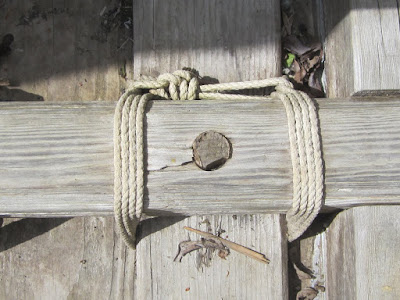I have done two posts before on the "Holgar", specially built for a Discovery Channel TV programme designed to show how 80 bluestones might have been transported from Pembrokeshire to Stonehenge. The programme always was rather ludicrous, since a boat like this (based upon the Ferriby boats) could not have had anything to do with bluestone transport -- since the design is at least a thousand years too late. I have also pointed out that the Holgar was vastly more sophisticated than any local Bronze Age boat (let alone any local Neolithic boat) might have been, since it was built with modern tools, modern materials and modern boatbuilding expertise........
https://brian-mountainman.blogspot.com/2018/11/holgar-and-bluestone-voyage.html
https://brian-mountainman.blogspot.com/2012/10/latest-discovery-channel-spectacular.html
I have a pdf of a short article by Nick Newland on the building of the boat, with an extra piece added by Will Donaldson on "the voyage." It anybody wants a copy, let me know.
Anyway, I discovered recently that the Holgar now lies quietly at the riverside at Castell Henllys, the site run by the Pembs Coast National Park showing what life might have been like in a small Iron Age hilltop village. I went over there today to check it out, and found that the boat has simply been abandoned there, very much unloved, with weeds growing inside and out, assorted debris and litter inside, and no attempt at all to explain what it is and what it might have been used for. An educational opportunity completely missed...... no matter what one might think about the daftness of the TV programme or the lack of authenticity in the building process, the boat is after all beautifully built by people who know about the building of wooden boats, and it should at least be respected on those grounds. It's a nice example of an experimental archaeology project which probably proved that in the Neolithic people could NOT have moved 80 bluestones by sea -- but negative results are often more useful than results deemed to have been positive. (I have no doubt at all that the dodgy but predictable conclusion of the Discovery Channel programme was that "Yes, it could have been done!")
I was surprised by the size of the craft. It's about 14m (46 feet) long and over 2m wide, with room for a crew of 14, of whom 12 would have been rowers, sitting side by side on 7 sturdy seats. Here are a few images:
What struck me forcefully on examining the boat was the timbers have been beautifully sawn and shaped, even with laminates used in some places. The hundreds of holes are machine drilled,and the wooden dowels are perfectly circular in section. There are hundreds of metres of cord used in "sewing" the planks together -- and the builders have used nylon cord, not rough rope made from brambles or nettles. The accuracy of the plank fitting is impressive, and this minimised the amount of caulking needed -- but there is no way that anything like this could have been achieved in the Neolithic, without metal tools. Even this modern version of the Ferriby Boat was apparently very leaky when on the water and when carrying a rather small bluestone. The platform fixed to the flat bottom of the boat amidships (to support the weight of the stone) was supported on three cross timbers, fixed in with metal bolts. There are other metal fittings too, as seen in the lowest photo.
Anyway, a word of appreciation for the boat builders, who have created a thing of beauty to an ancient design. But having examined it, I am more than ever convinced that no seaworthy craft capable of carrying 4 tonne monoliths could have been built in the Neolithic.
But a word to the National Park -- please take better care of it, and use it to encourage debates on the origins and the transport of the bluestones!
-------------------------
PS. It's rather ironic that the Millennium Stone on its sledge is now dumped, sad and neglected, at the National Botanic Garden of Wales, and that the Holgar is now also dumped, sad and neglected, at Castell Henllys. They have both been used for re-creations of the great national bluestone transport myth, but they should be better looked after and used in the context of a sensible debate.








1 comment:
Hi Brian, thanks for highlighting the plight of a Holgar! I was part of the crew who carried her from Cardiff to just past Bristol in 2012. I’m still in touch with a number of the crew and last year stayed with Captain Tizoc in New York. As mentioned I’m in contact with Sue Greaney at EH, hopefully they can help.
Post a Comment